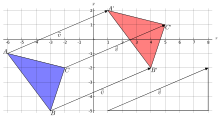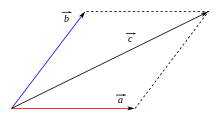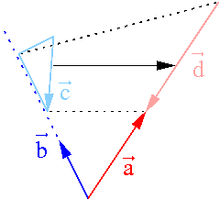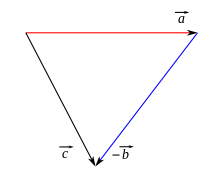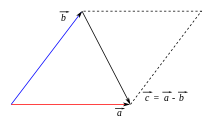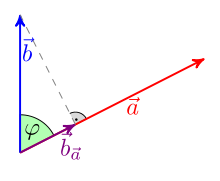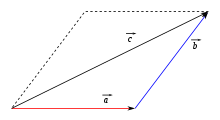Euclidean vector
![]()
The title of this article is ambiguous. For other meanings, see Vector (disambiguation).
In a general sense, in linear algebra, a vector (lat. vector "carrier, driver") is understood to be an element of a vector space, that is, an object that can be added to other vectors and multiplied by numbers called scalars. Vectors in this general sense are discussed in the article Vector Space.
In the narrower sense, in analytic geometry a vector is understood to be a mathematical object that describes a parallel displacement in the plane or in space. A vector can be represented by an arrow that connects an original image point with its image point. Arrows that are of the same length, parallel and oriented in the same way describe the same vector. In Cartesian coordinates, vectors are represented by pairs of numbers (in the plane) or triples (in space), often written one below the other (as "column vectors"). Vectors can be added and multiplied by real numbers (scalars).
Motivated by the coordinate representation of geometric vectors, 



This article deals mainly with vectors in the geometric sense and with vectors as elements of the "tuple space" 
Closely related to geometric vectors are vector quantities in physics. These are physical quantities that have a magnitude and a direction, and are often represented by arrows whose length corresponds to the magnitude of the quantity. Examples are velocity, acceleration, momentum, force, electric and magnetic field strength.
History
Vector calculus was founded by Hermann Günter Graßmann, who published his Ruler Ausdehnungslehre in 1844, a book of over three hundred pages. Among others, René Descartes and August Ferdinand Möbius, a student of Carl Friedrich Gauss, are considered as precursors. Around 1850, the Irish mathematician Matthew O'Brien used the vector calculus to describe mechanical facts, but remained largely ignored. Almost simultaneously, William Rowan Hamilton developed his similar theory of quaternions, which he published in the book Lectures on Quaternions in 1853 and in the work Elements of Quaternions in 1866. In Germany the vector calculus was spread especially by lectures and books of Alfred Bucherer, August Föppl, Carl Runge, Fischer, v. Ignatowsky and Richard Gans.
Spelling and speech
Variables representing vectors are often marked with an arrow ( 






Geometry
Definition
In geometry, a vector is an object that describes a parallel displacement in the plane or in space. A displacement can be represented by an arrow connecting an original image point with its image point. Arrows that are parallel, of the same length and direction describe the same displacement and thus represent the same vector. For example, in the image on the right, the arrow from 






An arrow is a directed line, that is, a line in which a sequence of endpoints is specified. Two arrows are called equivalent if they are parallel, of the same length and directed in the same way. This defines an equivalence relation on the set of arrows of the plane or space. The equivalence classes are called vectors.
Another way is to identify a vector with the parallel displacement represented by it. "Vector" is then just another way of saying "parallel displacement".
The vector describing a displacement 












The reverse vector 







Location and direction vectors
→ Main article: Location vector
Vectors can also be used to denote points in space. Thus, the location of the point can be denoted 
can be represented. This vector is called the location vector belonging to

To distinguish them from each other, vectors as described in the previous section are also called direction vectors. Two direction vectors are identical if they have the same magnitude and direction. However, as shown, they can have any point in space as a starting point, while location vectors always start from the coordinate origin.
This distinction is important, among other things, in analytic geometry. There, for example, a straight line is described by the following equation:
The support vector 



Representation in coordinates
If, as in the figure above, a rectilinear coordinate system is given, a vector of the plane can be described by an ordered pair of numbers, a vector in space by a triplet of numbers. Usually, these coordinates are written one below the other as so-called column vectors. For the vector in the plane describing the displacement by 7 units to the right (in 









The coordinates of a vector can be calculated as the difference of the coordinates of the end and start point. In the example above, 




Amount and direction
Unlike scalars, vectors have a direction. A vector is therefore characterized by its magnitude and its direction. The direction is given on the one hand by the axis position, on the other hand by the direction sense. The sense of direction indicates in which of the two directions along the axis the vector points. A change of sign in the magnitude of the vector corresponds to the reversal of the sense of direction.
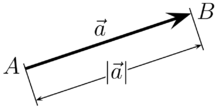
A vector from start point A to end point B and its length
Arithmetic operations
Addition and subtraction
The addition of two geometric vectors corresponds to the back-to-back execution of the associated displacements. If the vector 








Geometrically, therefore, two vectors 


Alternatively, the two vectors are represented by arrows with a common starting point and this figure is completed to a parallelogram. The diagonal arrow from the common starting point to the opposite corner then represents the sum of the two vectors. In physics, this construction is used for the parallelogram of forces.
In coordinates one calculates the sum component-wise: For the sum of the two vectors

applies

The associative and commutative laws apply to the addition of vectors.
For the difference of two vectors 


It can be interpreted geometrically in two ways:
- As the sum of
with the counter vector
of
. One places the starting point of an arrow representing the counter vector of
the end point of the arrow
representing
- As that vector which, when
added to
gives even If
and
by arrows with the same starting point, is
represented by the arrow leading from the endpoint of the second vector to the endpoint of the first vector.
If two vectors are added (subtracted), their amounts add (subtract) only if the vectors are collinear and have the same orientation. In the general case, however, the triangle inequality applies:
Multiplication with a scalar
Vectors can be multiplied by real numbers (often called scalars to distinguish them from vectors) (scalar multiplication, also called S-multiplication):
The length of the resulting vector is 
For vector addition and multiplication by a scalar, the distributive law applies:
The same applies to the addition of two scalars:
Scalar product
→ Main article: Scalar product
The scalar product (or inner product) of two vectors 



where φ is 


In the Cartesian coordinate system, the scalar product is calculated to be
in particular, the square of a vector is
Geometrically, the scalar product can also be understood as follows (see figure): One projects one vector 









This operation is often used in physics, for example, to calculate work when the direction of the force does not coincide with the direction of motion.
For the scalar product the commutative law applies
and the distributive law
Cross product
→ Main article: Cross product
The cross product (also vector product, outer product, or vector product) 





where the angle enclosed by the two vectors 
In the three-dimensional Cartesian coordinate system, the cross product can be calculated as follows:
The cross product is anticommutative, i.e., it holds
Spat product
→ Main article: Spat product
The combination of cross and scalar product in the form
is called a spar product. The result is a scalar. Its magnitude is the volume of the spar spanned by the three vectors. If the three vectors form a right system, then is 


Length/amount of a vector
In Cartesian coordinates, the length of vectors can be calculated according to the Pythagorean theorem:
This corresponds to the so-called Euclidean norm. The length can also be given in an alternative notation as the root of the scalar product:
Vectors of length 1 are called unit vectors. If a vector has the length 0, it is the zero vector.
For vector quantities in physics, one speaks of the magnitude of a vector instead of the length. One can consider a vectorial physical quantity 


of a helicopter flying at a constant altitude in a southeasterly direction through
and
represent. The magnitude of the path velocity 




Dyadic product
→ Main article: Dyadic product
The dyadic or tensorial product 




In the three-dimensional Cartesian coordinate system, the dyadic product can be calculated as follows:
The dyadic product is not commutative, i.e., in general
but distributive with vector addition:
It is also compatible with scalar multiplication:
The dyadic product gives rise to a new class of linear algebra objects, the matrices and linear mappings, depending on whether we are computing in coordinate space or vector space. By linking several dyads (as in 
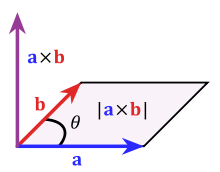
Illustration of the cross product

Scalar multiplication
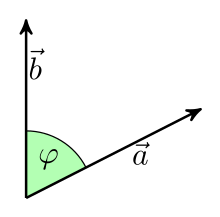
The scalar product of two vectors depends on the length of the vectors and the included angle
Component notation
As an alternative to the notation presented here as column vectors, vectors can also be represented in component notation. Here 

| Column vectors | Component notation | |
| Addition/Subtraction | | |
| Scalar product | |
|
| Amount | |
|
| Cross product | |
|
- ↑ a b c Using Einstein's summation convention.
- ↑ ε
is the Levi-Civita symbol and is +1 for even permutations of (1, 2, 3), -1 for odd permutations, and 0 otherwise.
See also the section Coordinates and components of a vector below.
n-tuples and column vectors
In generalization of the coordinate representation of geometric vectors, elements of 


Addition and scalar multiplication
The addition of two vectors 

The set 



Standard scalar product
→ Main article: Standard scalar product
The standard scalar product is defined by

With this scalar product, the 
Multiplication with a matrix
→ Main article: Matrix vector product
If 






Multiplication by a ( 


Length or standard
→ Main article: Euclidean norm
The length or norm of a vector is given by the square root of the scalar product with itself:
Besides this Euclidean norm, other norms are also used, see p-norm.
Row and column vectors
If we consider vectors as matrices, an 
for which there is a 
as the associated row vector, where is 



The dyadic product represents itself as the matrix product of an 


Vector properties
Linear dependence
Vectors 


However, if no coefficients 
In the case 
For in the case of linear dependence, at least one of the vectors 
To define a coordinate system for an 



Collinearity of two vectors
Two linearly dependent vectors 

Every vector is collinear with the zero vector. But if there are two vectors different from the zero vector, they are collinear exactly if
for an 


Orthogonality
Two vectors 

For geometric vectors with positive length this means that they enclose a right angle, see scalar product. The zero vector is orthogonal to any vector.
Standardization
A vector 

The vector 





Unit vectors are important in the representation of coordinate systems.
Coordinates and components of a vector
→ Main article: Vector space basis
For example, the most widely used coordinate system, the Cartesian, is an orthonormal system because it is derived from the three mutually orthogonal unit vectors 


Thus, any vector can be represented as a linear combination of the basis vectors by writing it as the sum of its components with respect to the basis:
By changing to another orthonormal basis 

More generally, any three but linearly independent vectors can be used as a vector space basis.
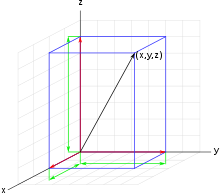
Vector (black) with components (red) and coordinates (green) with respect to a coordinate system (gray)
Generalizations
The definition of a vector in linear algebra as an element of a vector space is a much broader one, including a wide variety of mathematical objects (numbers, sequences, functions, and transformations) in addition to conventional, geometric vectors.
On the other hand, vectors are just one-step tensors, i.e. tensors with only one index.
Questions and Answers
Q: What is a vector?
A: A vector is a mathematical object that has a size, called the magnitude, and a direction. It is often represented by boldface letters or as a line segment from one point to another.
Q: How do we usually draw vectors?
A: We usually draw vectors as arrows. The length of the arrow is proportional to the vector's magnitude and the direction in which the arrow points to is the vector's direction.
Q: What does it mean when someone asks for directions?
A: When asking for directions, if one says "Walk one kilometer towards the North", that would be a vector, but if they say "Walk one kilometer", without showing a direction, then that would be a scalar.
Q: What are some examples of how vectors can be used?
A: Vectors can be used to show the distance and direction something moved in. They can also be used when asking for directions or navigating an area.
Q: How are vectors represented mathematically?
A: Vectors are often represented by boldface letters (such as u, v, w) or as a line segment from one point to another (as in A→B).
Q: What does it mean when something is referred to as scalar?
A: When something is referred to as scalar it means that there isn't any directional information associated with it; only numerical values such as distance or speed.
Search within the encyclopedia




